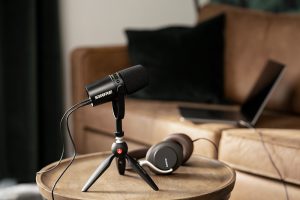Shure’s MV7 – a descendent of the famous SM7B vocal microphone – was designed to overcome the various limitations of home recording set-ups.
There’s a famous story in audio engineering circles concerning Bob Dylan’s 31st album, Love & Theft, released when the Nobel Prize-winning songwriter was 60 years old. Dylan is listed as the album’s sole producer, but there’s no denying the significance of engineer Chris Shaw, who helped Dylan generate the album’s bright, clean tones.
Shaw already had an impressive CV in 2001, including engineering and mixing credits on albums by Weezer, Super Furry Animals, and Butthole Surfers. But the thing that caught Dylan’s ear was the vocal sound Shaw captured for Public Enemy’s political hip-hop juggernaut, It Takes a Nation of Millions to Hold Us Back (1988).
So, Bob Dylan, in 2001, on his 31st record – a blues and roots rock affair, no less – was keen to emulate the vocal sound from one of hip-hop’s most incendiary releases? You bet, and the fact Dylan and Shaw continue to work together indicates Dylan got what he was looking for. So, what exactly did Shaw bring to the table? According to Bob Dylan: All the Songs, he brought a Shure SM7 vocal microphone, which, in 2001, was most famous for its use in radio broadcast studios.
Nowadays, the SM7 – or the updated SM7B model – is near synonymous with podcasting. Major podcast hosts such as Joe Rogan, Marc Maron and Conan O’Brien are SM7B users, and the microphone appears in innumerable articles about how to optimise one’s podcast audio.
The omnipresence of the SM7B prompted Shure to develop a spin-off mic, the MV7, which goes for nearly half the price. Shure’s MV7 was designed to meet the specific needs of podcasters, but, like Shaw and Dylan discovered with the SM7B, the MV7’s application needn’t be limited to podcasting.

Image of the Shure MV7 (Photo: Supplied)
Shure’s MV7 is ideal for home recording
Unlike the SM7B, which was developed with professional recording studios in mind, the MV7 was designed to overcome various limitations of home recording. At the risk of sounding like a crank, is there anything more annoying than listening to a podcast recorded on a laptop mic, through Zoom, or worst of all, over a shonky phoneline? By virtue of the MV7’s affordability and specialty design, such issues can be easily erased.
Shure advertises the MV7 as a microphone apt for making “perfect recordings in imperfect rooms.” This is possible courtesy of the mic’s Voice Isolation technology, which brings vocals to the front and blocks out pesky background noise (like burring washing machines or car engines).
Given that podcasts are predominantly listened to through headphones, the MV7 was engineered to emphasise vocal clarity and minimise ambient noise. As a result, the MV7 is also suited to live streaming and gaming platforms like Discord and Twitch. But if you find yourself working on a blues and roots rock record with Grammy-winning potential (a la Love & Theft), it’s also worth plugging in the MV7.
Convenience is king
Home studios are often ad hoc setups, occupying one half of a bedroom or getting assembled and disassembled on a daily basis. The MV7 is a convenient addition to any home studio. For one thing, it’s a digital microphone that plugs directly into your Mac or PC with a USB cable. The MV7 has a standard XLR input too, allowing you to run it through an audio interface or microphone preamp of your choosing.
The MV7’s on-mic touch pad lets you easily mute yourself and control gain, headphone level and monitor mix. There’s a 3.5mm jack input on the base of the mic so that you can plug headphones directly in and assess the raw audio signal.
The MV7 also syncs up with the ShurePlus MOTIV desktop app, which lets you fiddle with the EQ and adjust the settings of the mic’s in-built limiter and compressor. You can save presets in the MOTIV app or, alternately, select Auto Level Mode, which does the work for you, monitoring the sound and adjusting settings as you record.
The MV7 family is growing
Since launching the MV7 in 2020, Shure has come out with a few variations. The original MV7 is now available in black and silver. Meanwhile, the MV7X is a relatively simplified version that supports only XLR connectivity (thus doing away with the USB port and touch pad). The MV7X
is the most affordable of the bunch and especially suitable for podcasters who need to use multiple mics at once.
Then there’s the Shure MV7 Podcast Kit, which combines the MV7 with a PIXI Mini Tripod from Italian tripod specialists, Manfrotto. Manfrotto products are renowned for their durability, making the PIXI Mini a complementary match to the sturdy, all-metal MV7 and further boosting the integrity of your home studio.





































